
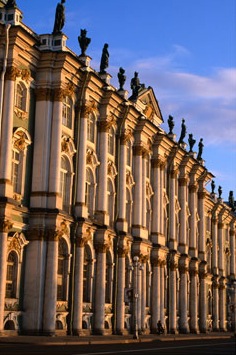
II. Leningrad
Under marble slabs the Tsars sleep
Their dank and mildewed sleep
In a cathedral in Leningrad.
In the glow of goldleaf wrapped
On the twisting columns of iconostases,
Old women light the votive candles
Of their resilient faith, as the young
In their secular ambivalence
Ponder the tomb of Peter the Great.
Books tell of the swamps and their
Pestilential breath that sired
This rival of old Muscovy,
Of conscript peasant, nobleman and serf,
The horde of infantry fed to the cold
Of the marsh and the crash of artillery—
Tributes to the Tsar’s grasp
Of the southern steppes in the war
Against the Swedes. It is from their
Namelessness a new Russia arose.
Here, now, named after a hero of another
War, is St. Petersburg: A late summer
Of colonnades and corniced windows,
Pink Italian facades staring down
The flood of morning traffic
On the endless stretch of Nevsky Prospekt,
As obese women and milk-skinned girls
Savor the last of the sun on the grass
Along the banks of the Neva—
Now almost still like lapis lazuli,
Veined here and there only by ripples
Stirred by geese, a child’s paper boat,
Cellophane wrapper, windblown birch leaf.
From the Lavra chapel under the lindens
Whose shadows dapple Dostoyevsky’s grave,
Newlyweds march to Alexander Square,
Pose beneath Karl Marx’s bust,
And affix their signature
To the posterity of a photograph.
Behind the colonnade on another square,
An older passion pulsates: lovers
Concealed behind pine and poplar swaying
In the beige skies of the tapestries
At the Hermitage. Faces, viewed and viewing,
Are transfixed on the Rembrandts
And the Murillos, the red dancers
Of Matisse, the blue girls of Picasso,
Van Gogh’s swirling impastos.
These hurried journeys through time
Root me down as I stand in the marble hall
That is the throne room of Peter the Great:
With all but a tourist’s awe, I am granted
This moment of true Russian drunkenness,
To revel in the terrible beauty
That survives all its human cost.
(1990)
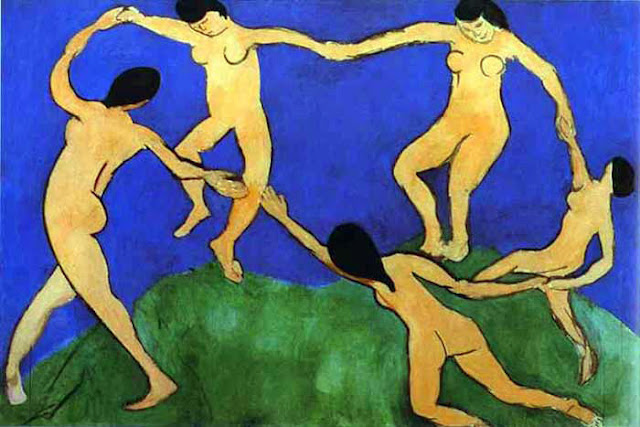
Matisse's Dance,
and Picasso's Absinthe Drinker at the Hermitage
III. Moscow
1. Epilogue 1990
Since I saw Moscow, it’s been more
Than half a year. Or half a lifetime
Even, I do not know, for half the world
Had changed—by terror or by temblor,
By the heaving of hearts or continents,
By the machinations of meretricious
Circumstance. Like dominoes, dictators
And dictatorships had fallen one by one,
From the Warsaw Pact to the American
Isthmus, relinquished by the powers
That sustained them—the native
Or the foreign hand. (Ours, long a client
Of one, had vanished at last, after
Lingering in banishment, leaving wounds
In our souls that wouldn’t heal.)
At the Eastern Bloc the Berlin Wall
Was crumbling into souvenirs
(Gorbachev’s face had been carved
Into the pages of Time), a playwright
Sits at the head of the Czech Parliament,
The Poles have voted their favorite
Unionman president. And the people, long
At the throes of their sordid heritage,
Are plunged into the Free World’s
Shoreless seduction: What economics
Or ideologies could save them now?
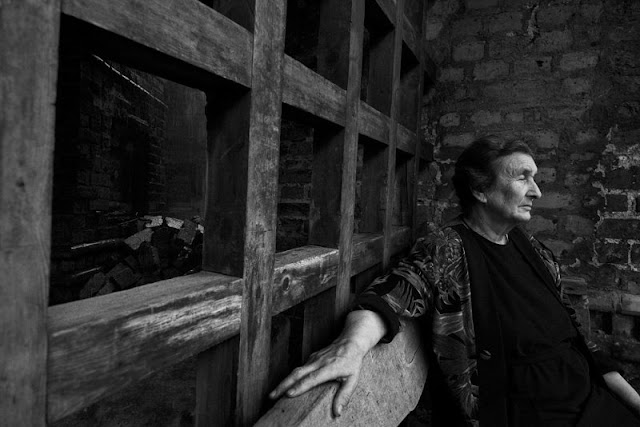
2. On the Overnight Express from Leningrad
Pine, fir, birch, in permanent expanse,
Escorted us across the dawn
Into the rotting outskirts of Moscow.
Leningrad left us sated and mortified
With the opulence of art at the Hermitage,
Loot and heritage of tsars and commissars
From world tours and world wars.
On the overnight express its memory
Had become a residual flatulence
Relieved by the quaintness of samovar
Dispensing the train attendant’s morning tea.
In the golden gray light Moscow awoke
With its frayed elegance of tenements
And factory smoke, as its million intent
Faces preened and slid into streetcars
And the smooth bowels of the Metro.
(Half in jest our guide observed: Here
People seldom smile, in this center
Of State the ambitious of Russia thrive...)
From afar, above the signs of Comecon,
Tungsram, Abloy, Cubafrutas, we glimpsed
Stalin’s spires transfixing the sky
With their sun-gilt five-pointed stars.
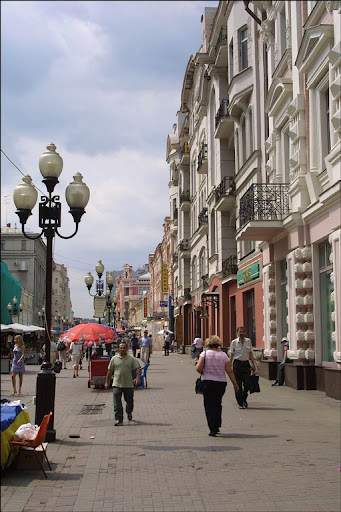
3. Arbat
Here converge the newly reborn
Zanies of Glasnost: Quaint Arbat,
A stretch of turn-of-the-century facades,
Lining the street like so many Potemkin props:
Victorian lampposts with their wrought-iron
Stems blossoming into globes of glass,
Bricked pavements preserved by law
From motor fumes. Pass by Arbat. Everyone
Meets everybody on ‘Perestroika Street’:
Beatniks time-warped, the truly hungry
And the truly lost, history’s gypsies,
Jongleurs of fate, flouters of convention,
Flaunters of indifference, preachers,
Visionaries, circus midgets, punks.
Bob Dylan’s doppelganger sings in a corner
For kopeks; two painted ladies smile at us
In the common language of the races:
We smile back—our Asian curiosity
In exchange for their Slavic secrets.
From behind a crimson door an Italian
Harlequin mimes us a surprise. At the next
Corner a miniature artist offers us his
Updated version of Hieronymus Bosch’s
Apocalypse: Purple and orange mezzotint
Of the final fireball that will engulf us all,
Signed by him, take note, who has
Exhibited in Paris. Listen. Here, perhaps,
Do the dimensions of empire teeter in equipoise:
Where four Lithuanian nuns still light candles
For their brethren slain by Stalin,
As the chattering provincials are disgorged
At an intersection by an Intourist bus...
While somewhere else in the city,
Beyond this liberalism’s Disneyland,
Crowds queue up at the state-owned shops
For precious beef and tomatoes, limp greens,
Rancid cheese, battered fruit and potatoes;
And over at the Armory, both the fashionable
And the tawdry line up for a precious view
Of the gem-encrusted eggs of Faberge.
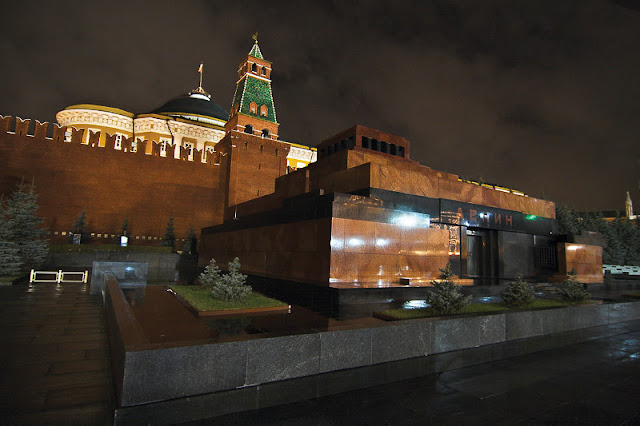
4. Red Square
That morning in Moscow I will never
Forget: As far as the dappled birches
Bowing in the sun by the Kremlin Wall,
Over asphalt and cobblestone,
Into the great patio under the cupolas
Of St. Basil’s that presided like
Turbaned caliphs over Red Square,
And under the lone spire of Spassky Gate
That kept watch with its stern
Military stare, the lines of devotees
Stretched from the doorstep of Lenin’s
Mausoleum, from the sunlight into
A crypt of red marble. At a signal from
The guards (‘Fix your ties, button up, please,’
Said the public address), a hush fell
Upon the crowd, the soul preened
Before crossing the threshold.
There lay what was left of a man
Who shone one October, heir to the yoke
Of peasant and serf crushed under
The wheels of the Industrial Revolution.
What vision he saw he seems to have
Taken with him under the glass
That shields him now from the world’s
Contagion, as he rests embalmed,
Preserved in the taxidermist’s perfection.
In this shrine of the Other Orthodoxy,
We, pilgrims from other conformities
Pay homage to him who did not conform.

5. White Night from the Hotel Rossiya
From the tall windows of the Hotel Rossiya
I gazed at the luminescent July night
And thought of the Russia my heart chose to see:
Mike’s demure Uzbeki, Zulia, eavesdropping
On our English as we marveled at the exhibit
Of Tolstoy’s memorabilia: Cravats and cobbler’s
Tools (he made his own boots), black
Tandem bike, the ubiquitous quill and ink well...
Or Sveta, the evening’s in-charge
Of the hotel desk, whom we wooed with poems
And cigarettes (the latter for her boyfriend,
We teased), but she just smiled.
Or Dmitri, our able guide, the smiling Muscovite,
Lover of Davao bananas safely tucked
In his attaché case among the tourist brochures,
Whose favorite American movie
Was Australian: ‘Dundee Crocodile’!
Or the omnipresent Matrioshka doll
In her deceiving simplicity: multiplying
Yet diminishing herself as if to infinity,
Smiling her lacquered smile at us
From the Berioska shelves.
But who could forget the plaintive
Chorus of bekerchiefed babushkas
In the Orthodox dusk at Zagorsk?
Or our ardent debates and vows of friendship
With the inebriated nationalist in Kiev?
Or Peredelkino, Moscow’s rural outskirt,
Where a spring purled in the quiet of Pasternak’s grave?
Ah, to know Russia, indeed. Or never at all.
I watched museum workers dig for artifacts
In an ancient corner of the Red Square,
And saw bricks crumble under the Kremlin Wall.
I fancied seeing the ghost of the Past
Haunt the Victorian malls of Gum,
Haunt the halls beyond this damp hotel room,
From where I, in my stranger’s conceit
Presumed to know what my heart could choose,
As if by gazing alone, one could peel,
Skin by skin, the onion domes of St. Basil’s.
Marne L. Kilates
(1993)
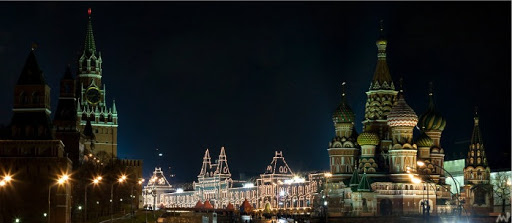
NOTES:
Plinfa. Gray-colored brick.
Leningrad. The city’s name has since reverted to St. Petersburg
Berioska. The Russian silver birch. The name adopted for the state-owned duty-free shops.
Gum. An acronym for something that escapes me now. Moscow’s version of the megamall.
PHOTOS from top: Facade of Winter Palace or Hermitage (the biggest museum in the world; it would take maybe a week to see all its galleries. Mike Bigornia, Dmitri & I went running & skipping through the galleries in one afternoon); two of the famous paintings in the museum; Conversation in Rain by Maxim Popykin; Arbat Street; the Lenin Mausuleum at Red Square at the Kremlin; Novospassky Monastery onion domes; and, bottom, the Kremlin at night, with the Russian Parliament to the left, the GUM supermarket outlined in bright lights in the middle, and St. Basil's Cathedral to the right.
PHOTO CREDITS: Except for Winter Palace facade (above) and Arbat Street, all photographs by Maxim Popykin. Maxim is a web programmer for a cellular company. He hobbies include water sports, snowboarding, listening to techno music and traveling, especially to Italy and Greece. His dream is to travel to Norway, Venezuela, Canada and India but would never think of leaving home without a camera. He feels photography is an essential part of any trip. He current camera of choice is the Canon 300D. He was born and still lives in Moscow, Russia. See more of his stunning photographs at http://www.pbase.com/maximzar.
Arbat Street by Ana Sayfa; Paintings and others from the Hermitage and other academic websites
DATES: Parts I & II, composed in 1990; 2 to 4, 1991; 5, 1993
✑
Bilingual Statement of the Nation's Artists for Truth
IBALIK ANG TOTOO!
Statement of Artists and Workers in Culture and the Media
on the Sorry State of the Filipino Nation's Leadership
The role of the artistic community in any society is to mirror life through artful expression of our heritage, vision, and soul. It does so by reflecting the truth as experienced, witnessed and lived in people's everyday lives. To alter or manipulate the reflection of the truth in an artistic work renders the artistic expression void of resonance and meaning. On a larger scale, falsehood also mis-shapes our core values and misrepresents our identities as a people.
Sadly today, our people are experiencing an orchestrated obstruction and manipulation of the truth. As artists and workers in culture and the media, we are appalled by the blatant disregard of our rights of access to the truth and the contemptuous attempt to mislead us from the truth. As the issues of legitimacy, massive corruption, charges of human rights violations and social injustice plaguing the Arroyo government are being unraveled, we are witnessing the unprecedented viciousness in manipulating the truth to subvert the public good.
We view this development with increasing alarm as it threatens the very fiber of our national survival. As agents of truth, we assert that our role as artists is inextricably linked with our people's struggle for freedom, justice, and democracy. Genuine national unity and progress can never be achieved without thorough understanding of our culture and identities, a respect for the diverse ways we express them and an appreciation of what is true of ourselves, our society and the world we live in. Now, more than ever, we must acknowledge and lend unequivocal support to the arts and culture sector as it plays an even more significant role in catalyzing our sense of nationhood.
As we seek an end to the culture of corruption in all facets of our national life, we demand the full accountability of all state instrumentalities and personalities involved in recent scams that assault the basic moral fiber of our people and deprive us of our basic rights...freedom of expression; relief from mass poverty; access to education, health care and livelihood opportunities; equitable application of justice; assurance of safety and security from unlawful arrests; and many other entitlements due us but have been deprived us as citizens of a democratic society. Not only must the Arroyo administration account for its breaches of governance; it must be purged of corrupt elements primarily responsible for its own destabilization.
We urge all Filipinos to act NOW before it is too late. Let us exercise vigilance in ensuring the accountability of our officialdom for their decisions and actions; diligence in pursuing exposure of the truth; and active and willful participation in defending the truth. We stand committed with the rest of the nation in demanding a new moral governance that will provide our country with a legitimate and morally upright leadership we can all be proud of.
Ang tunay na Filipino, nagsasabi ng totoo. Naglilingkod ng totoo, ipinaglalaban ang totoo. Sigaw ng bayan, ipagtanggol ang totoo!
ARTISTA NG BAYAN PARA SA KATOTOHANAN
February 26, 2008
IBALIK ANG TOTOO!
Pahayag ng mga Alagad ng Sining at Mangagagawa sa Kultura at Midya sa Malungkot na Lagay ng Liderato ng Bansang Filipino
Ang tungkulin ng mga alagad ng sining sa alinmang lipunan ay maging salamin ng buhay sa pamamagitan ng malikhaing pagpapahayag ng pamana, bisyon, at kaluluwa ng lahi. Naisasakatuparan ito sa pamamagitan ng pagpapakita ng katotohanan tulad ng dinaranas, nasasaksihan at isinasabuhay sa araw-araw ng taumbayan. Dahil sa pagbago o pagbaluktot sa pagtatanghal ng katotohanan sa isang akdang pansining, nawawalan ng kabuluhan at kahulugan ang pahayag na makasining. Sa higit na malawak na pagtuturing, nililinlang ng kabulaanan ang ating mga batayang halagahan at nagpapanggap na kinakatawan ng ating lahi.
Nakalulungkot na sa kasalukuyan, sumasailalim ang sambayanan sa sabwatang pagbaluktot at paghadlang sa katotohanan. Bilang mga artista at manggagawa sa kultura at sa midya, nasisindak kami sa walang pakundangang pagsasaisantabi ng ating karapatang mabatid ang katotohanan at sa karumal-dumal na pagtatangkang iligaw tayo palayo sa katotohanan. Habang nailalantad ang usapin ng pagiging lehitimo, malawakang katiwalian, paglabag sa karapatang pantao at kawalan ng katarungang panlipunan na umuusig sa administrasyong Arroyo, nagiging saksi tayo sa walang habas na pagbaluktot sa katotohanan upang yurakan ang kapakanan ng bayan.
Lubha kaming nababahala sa mga pangyayaring ito dahil nagbabanta ito sa ating pambansang kaligtasan. Bilang mga alagad ng katotohanan, iginigiit namin na ang tungkulin ng mga alagad ng sining ay mahigpit na kaugnay ng patuloy na pakikibaka ng sambayanan para sa kalayaan, katarungan, at demokrasya. Hindi matatamo ang tunay na pambansang pagkakaisa at pag-unlad nang walang ganap na pagkaunawa sa ating kultura at mga katangian, paggalang sa iba't ibang paraan ng pagpapahayag sa mga ito, at pagpapahalaga sa totoo sa ating mga sarili, sa ating lipunan, at sa mundong ating tahanan. Ngayon, higit kailanman, kailangan nating kilalanin at mataos na ipagsanggalang ang sektor ng mga sining at kultura, lalo ngayong may napakahalaga itong gampanin sa pagpanday at paghubog ng ating pagkabansa.
Sa hangaring maiwaksi ang nakamihasnang katiwalian sa lahat ng sangay ng ating pamumuhay bilang isang bansa, hinihingi naming lubos na managot ang lahat ng ahensiya ng estado at mga personalidad na may kinalaman sa mga panlilinlang kamakailan na lumalapastangan sa batayang paninindigan ng bayan at nagkakait ng ating mga batayang karapatan tulad ng: malayang pamamahayag; lunas sa kahirapan; pagkakamit ng edukasyon, pangangalagang pangkalusugan, at mga oportunidad na pangkabuhayan; patas na paggagawad ng katarungan; garantiya sa kaligtasan at seguridad laban sa lahat ng labag sa batas na pagdakip; at marami pang naipagkakait sa atin bilang mga mamamayan ng isang demokratikong lipunan. Hindi lamang dapat managot ang administrasyong Arroyo sa mga pagkukulang nito sa pamamahala; dapat ding mawala rito ang mga elemento ng katiwaliang pangunahing sanhi ng sarili nitong pagbagsak.
Hinihimok namin ang lahat ng Filipino na kumilos na ngayon bago mahuli ang lahat. Magsikhay tayo sa pagbabantay at pagtiyak na mapanagutan ng ating mga opisyal ang kanilang mga pasiya at gawain; pagsikapan nating maibunyag ang katotohanan; at masigasig at buong-loob na ipagtanggol natin ang katotohanan. Naninindigan kami kasama ang buong bansa sa paghahangad ng bago at may dangal na pamamahala na may lehitimo at makatwirang pamumuno na tunay na ikararangal ng bayan.
Ang tunay na Filipino, nagsasabi ng totoo. Naglilingkod sa totoo, ipinaglalaban ang totoo. Sigaw ng bayan, ipagtanggol ang totoo!
ARTISTA NG BAYAN PARA SA KATOTOHANAN
26 Pebrero 2008
✑
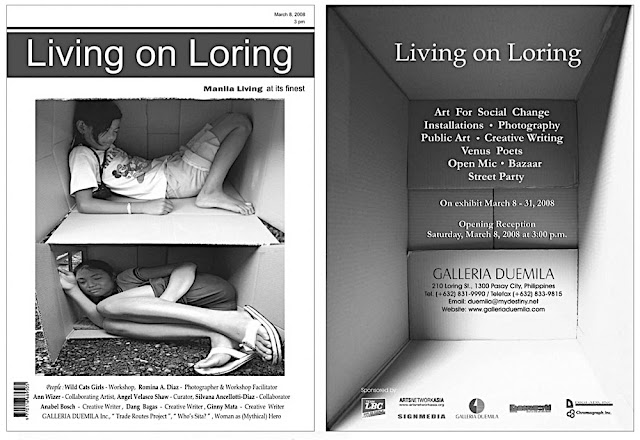
What do you do if you’re living in a box?
Two women artists enter the world of informal settlers, which is not too far from home.
Photographer Romina A. Diaz, who is half-Filipino and half-Italian, is able to step into the world of Loring Street in Pasay City because she lives there. Across from her family’s home and art gallery (Galleria Duemila), up to one end of the street, a large community of informal settlers have been living for decades.
Socially oriented artist Ann Wizer, a half-Norwegian/half-Lebanese American, collaborates with Romina on a creative project involving the girls from the community. Both have lived in Pasay, and both call themselves global nomads.
Their passions and social consciousness come together as they work with the young girls, aged nine to 16. For ten weeks, Romina worked with them in an intensive photography workshop.
The results are glimpses and images of their lives, mainly from their own eyes, with the help of the creative device of photography. The girls of Loring Street have also made ‘dollhouses’ out of LBC’s balikbayan boxes, which are representations of their lives, their homes, and their dreams.
Society often ignores girls like them: girls living in squalor, denied decent shelter, basic education, and proper healthcare, forced to become full-time mothers to their younger siblings, trying to survive in the huddled mass of shanties they call home.
One result of the project is “Living on Loring, Art For Social Change.” It is the collaborative exhibit by Romina, Wizer and the girls of Loring who call themselves Wild Cats Girls.
Angel Velasco Shaw, a film/video artist, writer, cultural activist, curator, and educator curates the show.
An artist with extensive experience in cultural exhange and activism, Velasco Shaw is the co-editor of the award-winning anthology, Vestiges of War: The Philippine-American War and the Aftermath of an Imperial Dream: 1899-1999 (New York University Press, 2002), among other notable works.
Velasco Shaw is currently working on a multi-year series of cultural exchange projects called ‘Trade Routes: Converging Cultures — Southeast Asia and Asia America.” “Living on Loring/ Who’s Sita?” is the flagship project of this series.
“Living on Loring, Art For Social Change,” an exhibition by Romina A. Diaz, Ann Wizer, and The Wild Cats Girls, is presented by Galleria Duemila from March 8-31, 2008.
✑
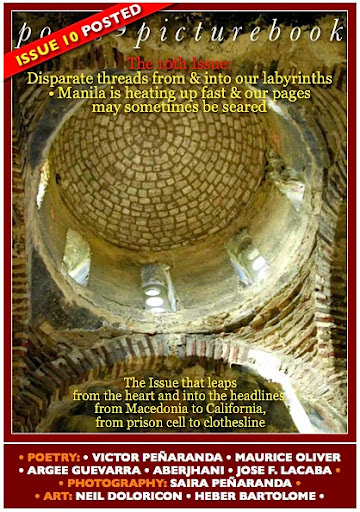









No comments:
Post a Comment